Research and Consultancy Project pdf
38 Pages17489 Words19 Views
Added on 2021-02-19
Research and Consultancy Project pdf
Added on 2021-02-19
ShareRelated Documents
Research and ConsultancyProject

List of Abbreviations1.RM - Ringgit Malaysian2.MDTCA - Ministry of Domestic Trade and Consumer Affairs3.MSMEs- Malaysia Small and medium-sized enterprises4.E-Commerce – Electronic Commerce5.E-retailers- Electronic RetailersAbstractThis thesis titled Malaysian’s Consumer Purchase Behaviour in e-Commerce has clearlyshowed the interest of shoppers in all over Malaysia, which are turning from physical storespurchasing to online shopping, this is due to online shopping has given ample number ofopportunities to shoppers, where they could directly purchase a product without going to anyparticular shop or store of a particular brand. Online shopping has enabled them to just tap or clickon the buy button, fill up some information like address, paying option and in next two to three daysthe purchased item will be on the buyer's door. On the other hand, it can be said that Lazada andShopee have been really very crucial for Malaysian economic conditions.Besides, it has also been found that e-commerce in Malaysia is continuously expanding andthis has given high range of benefits not only for the e-commerce platform and sellers, also forcustomers as well. Over the year, smart devices along with high speed internet technology hasraised ample number of opportunities to increase organisation profit but threat also arise, wherecustomers might receive the duplicate or replica of the original products. Therefore, in order tomaintain the presence within the Malaysian market and to develop market share, it will be requiredfor the e-commerce platforms to understand what influence customer decision to purchase online,as a result customer will remain loyal to e-commerce platform.
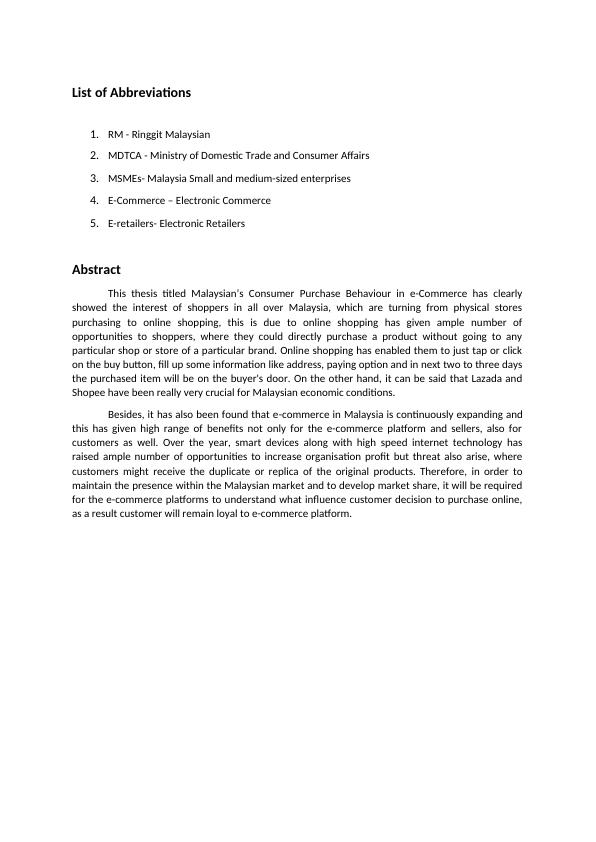
Table of ContentsList of Abbreviations..............................................................................................................................2TOPIC - Malaysian’s Consumer Purchase Behaviour in e-Commerce....................................................41. Introduction.......................................................................................................................................41.1 Research Background............................................................................................................41.2 Research Aim and Objective..................................................................................................51.3 Research Questions and Hypotheses.....................................................................................51.4 Thesis Structure.....................................................................................................................62. Literature Review ..............................................................................................................................62.1 Online consumer purchasing behaviour................................................................................62.1.1 Online shopping behaviour.................................................................................................62.1.2 The characteristic of Malaysian online shopping population............................................112.1.3 Online shopping process...................................................................................................132.1.4 Factors that influence online purchase intention.............................................................133. Research Methodology....................................................................................................................153.1 Rationale for the Research design and methodology..........................................................153.2 Validity and Reliability.........................................................................................................173.3 Questionnaire design...........................................................................................................183.4 FREQUENCIES......................................................................................................................194. Findings/Results:..............................................................................................................................214.1 Thematic Analysis................................................................................................................214.2 Suitable datasets are used and included for studies that employ secondary research.......285. Analysis and Discussion of Findings:................................................................................................286. Conclusions and Recommendations................................................................................................336.1 Conclusions..........................................................................................................................336.2 Recommendation................................................................................................................346.3 Limitation and scope of research.........................................................................................357. Reference.........................................................................................................................................37
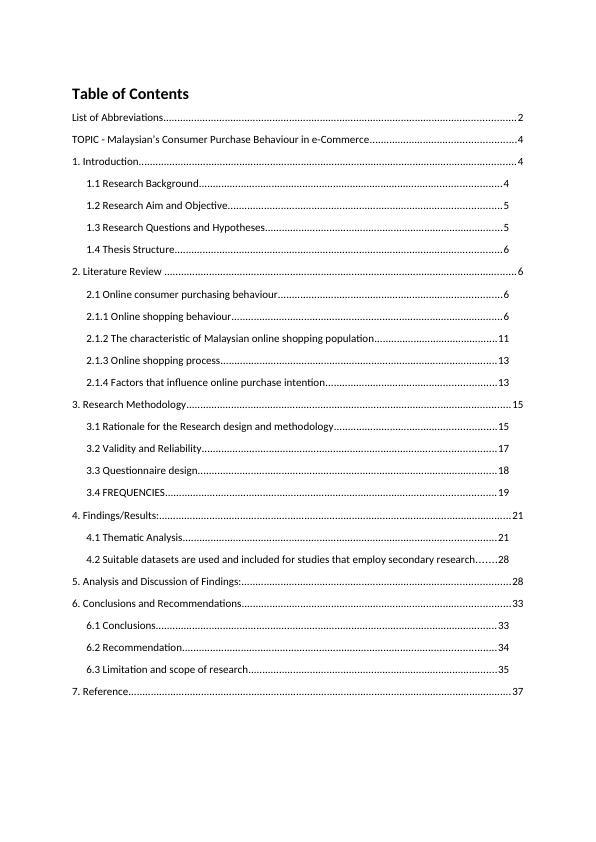
TOPIC - Malaysian’s Consumer Purchase Behaviour in e-Commerce1. Introduction1.1 Research BackgroundCommerce has been implemented since ancient time where generally commerce refers tothe exchange of goods, services or something value trade between business or individual. Over theyear there are laws that created to protect commerce, promote commerce and at time bancommerce of certain goods. With the rapid development of the technology and internet, commerce has expanded to e-commerce (electronic commerce). E-commerce can be classified in two subgroups in terms of sales,B2B (business-to-business) and B2C (business-to-consumer) e-commerce. The idea which is the tradeof goods and services using the internet as a medium to conclude transaction being carried out withthe use of the internet. This new channel has made it possible for customers to gain greaterbargaining power, therefore this newly found power within consumers has made it imperative forproducers to understand consumer behaviour (Hunt, 2000). E-commerce can be defined as anymarketing activity like buying, selling, advertisement, promotion, distribution, customers value andall other kind of marketing activities done with the help of using online technology to transfer goodsfrom seller to buyer online, the most popular e-commerce platforms in Malaysia are Lazada, Shopeeand Facebook. Through e-commerce platforms, consumers research detail about the product orservices they want, and able to compare the same products with different merchandise to select thebest rated seller with lowest price.E-commerce in Malaysia is continually expanding and growing as the development ofworldwide force and the development of smart devices with high speed internet technology andinfrastructure. Internet usage in Malaysia has grown rapidly and has become a common way fortransaction of products, services and information (Albarq, 2006). The detailed information andimproved service attracts more people to changed their consumer behaviour habit from traditionalmode to more rely on the e-commerce, resulted in the increase of online shopping, thus companieschange their marketing strategy to fit into e-commerce. Apart from that, e-commerce has no timelimit, its available 24/7, which allow consumers to shop at their convenient time. However, with thehigh level of competition, e-commerce platforms are giving out coupons on every festival season toattract new customers and retain existing customers. (Armstrong and et. al, 2014)According to the Advertising Marketing website, Malaysia e-commerce platforms have atotal average of 184.4million visits on desktop and mobile web in the first quarter of 2019. Malaysiae-commerce platform (Shopee) has seen doubled the number of downloads of its app at 20 millionto-date, this is achieved through creative branding and communication efforts, this is becauseMalaysian government’s initiatives in accelerating growth of e-commerce as part of the National e-commerce Strategic Roadmap. As a result, Malaysia e-commerce platforms ensure that Malaysia ison track to achieve its projects annual e-commerce growth of 20% in 2020 (Malaysia’s e-commerceindustry poised for strong growth in 2H19, 2019). Malaysian Communications and MultimediaCommission (MCMC, 2015) expects that Malaysia's online retail sales figures to exceed the 6.1%projection (RM22.6 billion) by Frost and Sullivan by 2020 (Top eCommerce platforms in SoutheastAsia, 2019).As the increase in population of online shoppers in Malaysia, e-commerce platform providesgreat opportunity for merchants who like to sell products on e-commerce, unfortunately this may
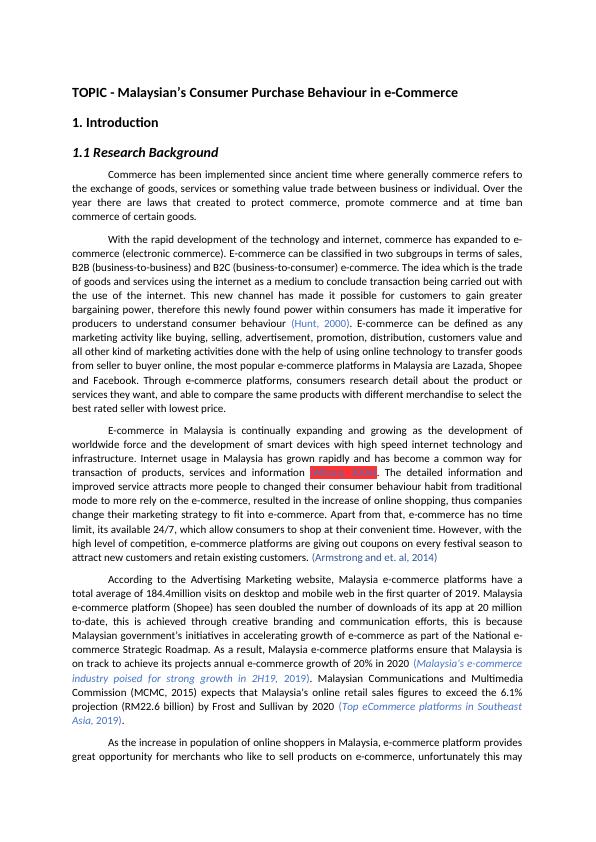
also bring challenges because the competition between traders will become increasingly fierce sincethe increase in enterprises and individuals has been participating this magnificent e-commercemarket, this is mainly due to the low entry barrier where the cost to enter and exit from e-commerce platform is low. Therefore, the dealers would have to seize the opportunity to allow themto stand out from the long list of competitors.The developmental features of internet have led to a huge difference between onlineconsumer purchasing environment and traditional purchasing circumstance as the result ofintangibility and virtualise of online network (LI et al, 4, 2008). Therefore, it is fundamental toresearch on the online consumer purchase behaviour in Malaysia and the influence factors onMalaysian’s consumer online purchase decision.1.2 Research Aim and ObjectiveThe objective is to investigate the factors that influent online consumer purchasingbehaviour in e-commerce, specifically in Malaysia e-commerce market, that include factors such aspsychological, social, culture, quality and price factors toward online marketing that could haveimpact on the customers’ online shopping decision. Besides, also understand Malaysian onlinepurchase behaviour and to identify the majority age group that purchase from e-commerce. it iscrucial for consumer behaviour scholar and e-retailers to have a deeper understanding on thefactors that influence their online purchase intention and the behaviour toward e-commerce, inorder to attract new customer and retain existing customer. 1.3 Research Questions and HypothesesThe current research is aiming to answer the questions below: -i)What age group form the major part of the online customers in Malaysia?ii)What is your most popular category of item beingrepeatedly purchase online?iii)How often do you purchase item from online stores?iv)What main factors affect the online consumer decision when considering and making apurchase over the internet?v)How does the level of computer literacy of the target group relate to the level of Internetpurchases?1.4 Thesis Structure1.Introduction:This thesis starts with background, issue that has been taken intoconsideration within the report and introduction of Malaysia e-commerce platforms withsome figures as supporting, it then explains on the research aim and objective to reflects themain conceptual framework for e-commerce, follow by research questions that derived fromthe research gaps. 2.Literature Review:The literature chapter analyses the features of online consumerpurchasing environment and the characteristics of online consumers, this allow tounderstand the relevant elements that may affect consumers online shopping behaviour.This includes reviewing on the aspects of cultural factors, social factors, environment factorsand individual behaviour factors. Moreover, a critical review of the performance of Lazadaand shopee with graph to identify the gaps in current knowledge.
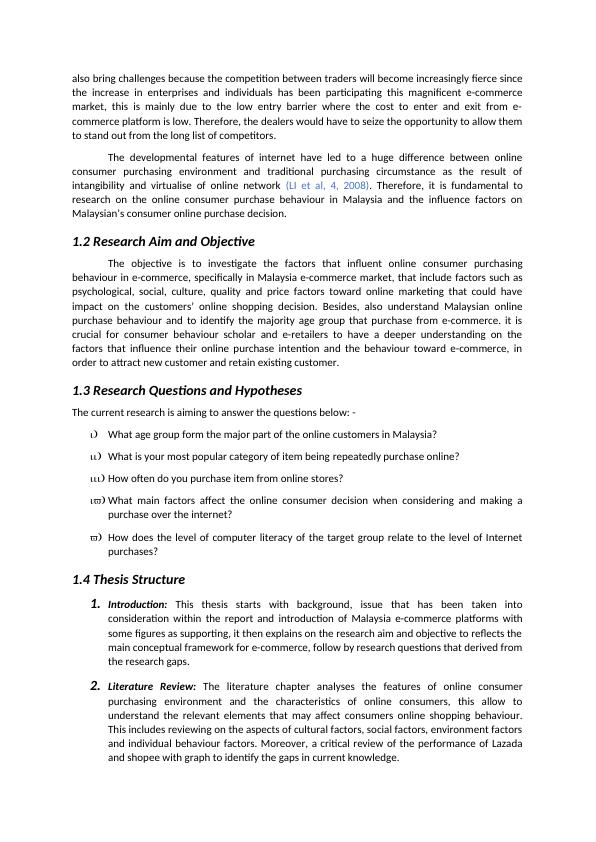
3.Research Methodology:The research methodology chapter outline the method of researchimplementation by applying theory and data collection. Besides, elaborating the limitation ofsurvey created for research purpose in this thesis. Along with this, a questionnaire is alsogoing to be developed in present report.4.Findings/Results: This section of the report is going to be enclosed with interpretations ofthe data collected, which has been taken into consideration from the developedquestionnaire. This led to the overall findings in meeting the requirements of the project. Asa result, reaching to the desired goal which is finding out favourable outcomes of researchproblem. (Arora and Aggarwal, 2018)5.Analysis and Discussion of Findings: This chapter describes the feedback from questionnaireby analysing the figures, to understand the effective factors from Lazada and Shopee’sconsumers, in order to provide suggestion to Malaysia online shops in the operation processof marketing.6.Conclusions and Recommendations:The final chapter concludes on the finding of theresearch by answering the research questions, and giving appropriate recommendations. Inaddition, discuss the limitation of the research and predicting direction and possibility offurther research. 2. Literature Review2.1 Online consumer purchasing behaviour2.1.1 Online shopping behaviourOnline shopping is a form of electronic commerce that allows the consumers to purchasegoods directly from sellers over the internet, therefore consumers must have access and knowledgeto the internet (Bak and Boulocher-Passet, 2013), (HE,2004). Online shoppers in Malaysia seem tobe younger than traditional shoppers in age. Although, there are increase of older generations thatare online now than in the past, but young people still dominate the online population in Malaysia,this is due to the younger generation not only more familiar with e-commerce but also quicker toprocess website information (Kim and Ammeter, 2008).As the improvement of e-commerce market and the development of internet technology,online shopping becomes a brand-new trend and receives a growing number of attentions from thepublic in Malaysia. This also attracted many scholars doing research on consumer online purchasingbehaviour from all different aspects that focus on their country. For example, In China, Wang (2001)researched on the factors that based on demographics, customer characteristics and transactionsecurity. While some scholars did research from the aspects of their own nationality people’sattitude toward purchasing on the internet.
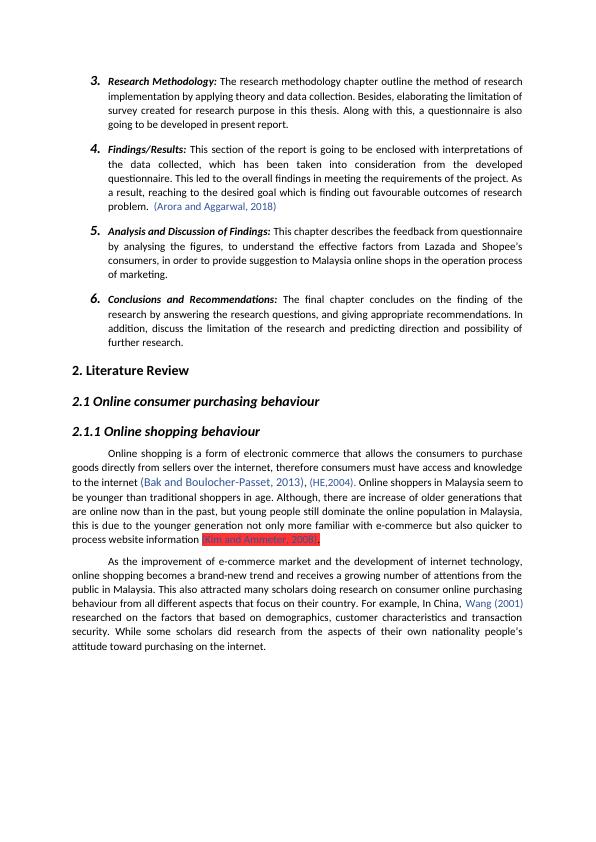
(Source: Malaysia's online shopping behaviour in infographic, 2019)The above infographic illustrate that Malaysian prefers online shopping than purchasingproducts and services from physical stores. The above-mentioned figure is showing thatmost Malaysian use desktop computers for e-commerce with the percentage of 68%. On theother hand, 1 from 3 online transaction by consumers were made through smartphoneswhich give 31%. On the other side, tablets have the highest average order value which haveRM339. Follow by smartphones RM314, and lastly, RM284 by desktop. As well as it has alsobeen found that women in Malaysia shops more than Males through online websites wherearound 58 out of 100. whereas, only 42 out of 100 males in Malaysia shopping from onlineportal. Along with this, considering the above figure it can also said that more than 51% ofMalaysian online shoppers basically coming in between the age of 18 – 34.(Sources: Weekly Average Spending of the different races, 2019)Illustration 2: Weekly Average SpendingIllustration 1: Malaysia's online shopping behaviour in infographic, 2019
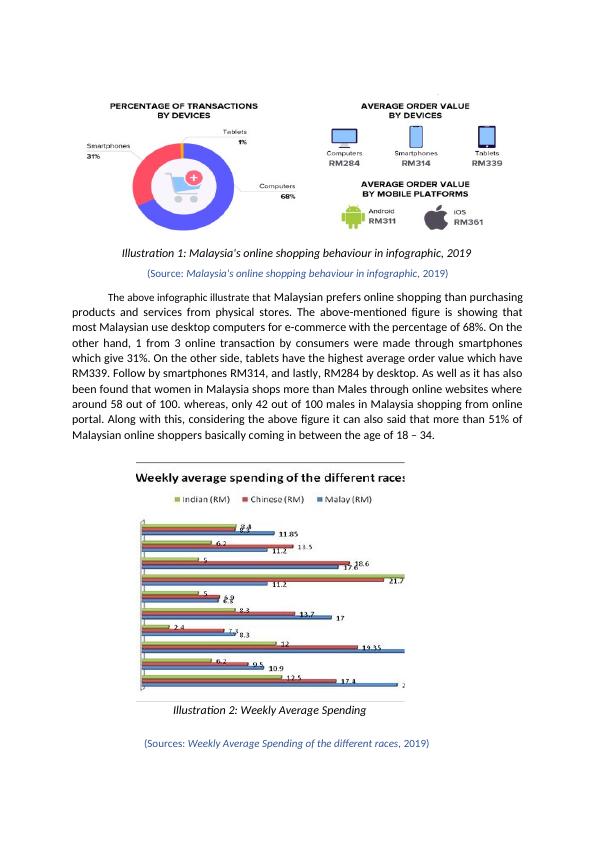
According to the above graph, where most of the blue lines are Malaysians Malay groupwhich are showing that on weekly basis that they spend most money on purchasing products andservices by e-commerce such as Shopee and Lazada. The figures have showed the average spendingin e-commerce of consumers in Malaysia in Malaysia currency (RM). On the other side, the red linesrepresented the Malaysia Chinese group, where the numbers like RM8.3, RM13.5, RM18.6, RM21.7,RM17.4 and more are showing that they spend less than Malay group but more than Indian groupfor online purchasing. Apart from this, green lines are for Indian group who is less active in e-commerce. The main reason for the variance of interest in e-commerce is due to the trust in e-commerce, because they believe that they may not get the original products which belongs to thebrand that they purchased. However, in general it can easily be said that consumers in Malaysia stillspend much more on weekly basis in e-commerce than any other country like China or India.Therefore, this has given high range of benefits to Lazada, Shopee and its merchants or sellers thatare dealing in e-commerce industry (Kamalul Ariffin, Mohan and Goh, 2018). Lazada and Shopeeboth has found this as an opportunity and offering targeted customers with high range of brandedproducts and services with promotion code. Through this, Shopee and Lazada has developed anumber of strategies in regards to keeping up the interest of consumers that have high expectationtowards their products and services offered by them through their web-stores and live chat service.Both Shopee and Lazada have basically made a range of strategies such as shop-in-shopdesign. This type of retail concept is something like where a brand owner basically developsspace among their own retail store. This is where e-commerce platforms sell products of otherbusiness organisations. For example, Lazada has made its shop-in-shop that designed based onstores in China and named it as Tmall flagship. As a result, this helped Lazada to sustain within themarket for a longer period of time. Lazada has become one of the top famous Asian e-commerce platform, which was found inthe year of 2012 and in present, the company is holding number one position in Asia. With the helpof its unique strategies and brand name, Lazada has grabbed attention of consumers and becomesuccessful in past few years till present, especially in a range of countries like Philippines, Indonesia,Malaysia, Singapore, Vietnam and Thailand.On the other side, Shopee is the direct competitor of Lazada where it is also operating as ane-commerce platform, which is also dealing in the same industry in Asia. In order to enhance theconsumer behaviour in a positive manner, Shopee has taken into consideration of many strategieslike daily flash sale, discount strategies and appointed Cristiano Ronaldo as its newest brandambassador (Mohseni and Okumus, 2018). This has helped them in sustain within the market for alonger period of time and added competitive advantage to the business. (Edwards and Bowen, 2013)
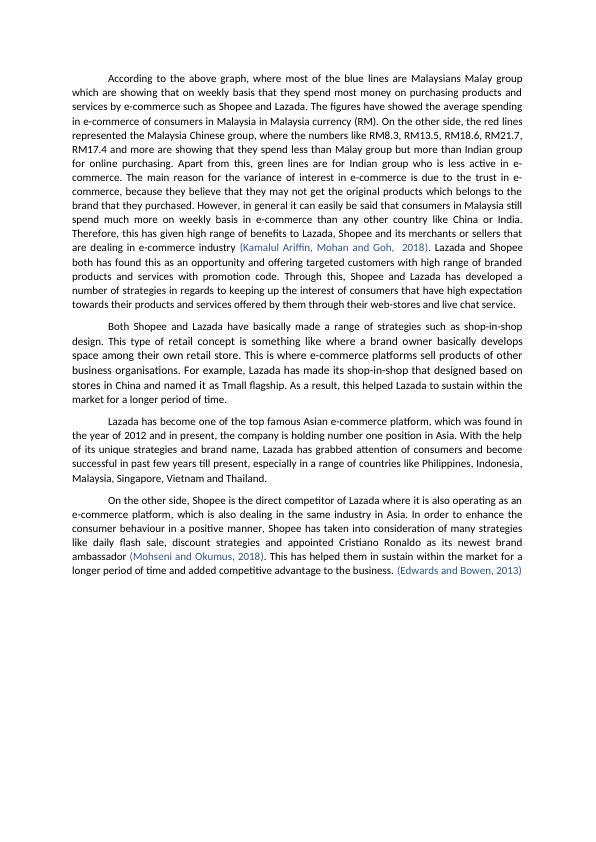
End of preview
Want to access all the pages? Upload your documents or become a member.
Related Documents
Factors Affecting Impulse Purchasing in Online Food Delivery (pdf)lg...
|24
|6348
|45
MANAGEMENT. Management Name of the Student Name of thelg...
|62
|13304
|353
Determinants of E-Commerce Adoption Assignmentlg...
|59
|18176
|73
Business and Management Dissertation (Doc)lg...
|14
|4213
|293
Research Project Assignment - Impact of Online Shopping on Customer Satisfactionlg...
|26
|7947
|452
Consumer Behaviour in Online Shopping- A Study of Chinalg...
|10
|2428
|469
